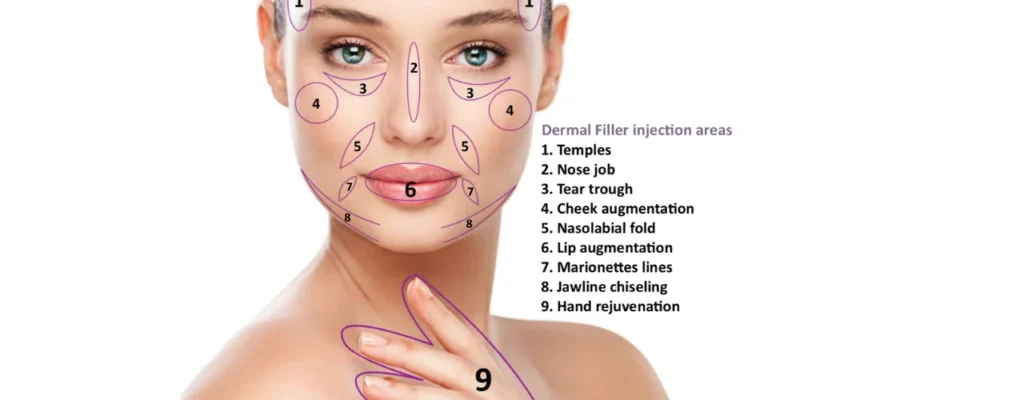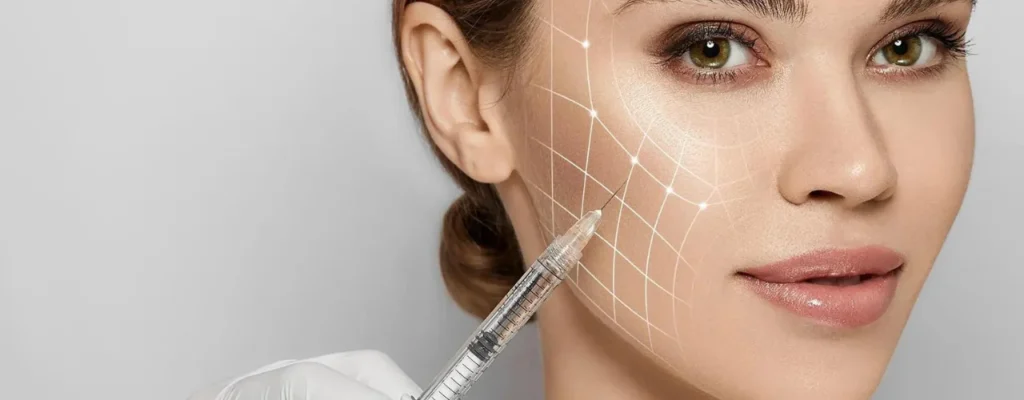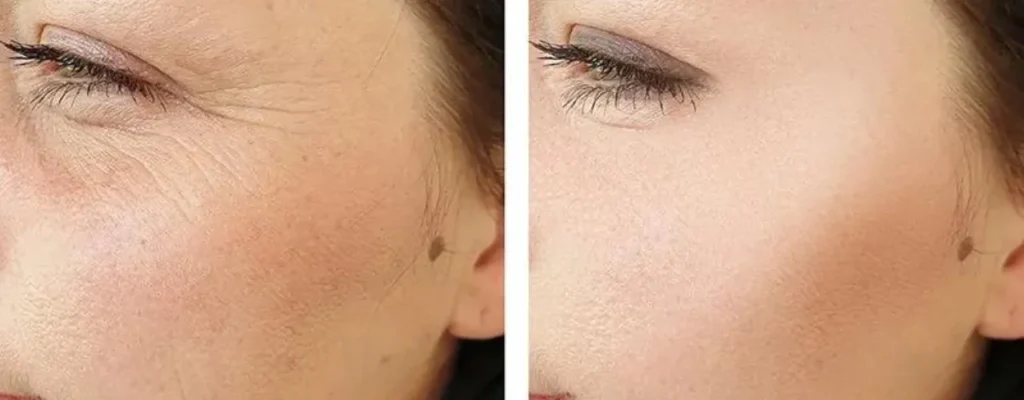Dermal Fillers: Fill the Lines and Plump Up Volume

Dermal fillers are gel-like substances that are injected beneath the skin to add volume, reduce wrinkles and folds, and enhance facial contours. They’re made from a variety of materials, including:
- Hyaluronic acid (HA): This is a naturally occurring sugar molecule in the skin that helps keep it hydrated and plump. HA fillers are temporary, lasting anywhere from 6 months to a year.
- Calcium hydroxylapatite (CaHA): This mineral is found in bones and teeth. CaHA fillers are slightly firmer than HA fillers and can last for up to 2 years.
- Poly-L-lactic acid (PLLA): This is a synthetic material that stimulates collagen production in the skin. PLLA fillers are the most long-lasting, typically lasting for up to 5 years.
What can dermal fillers be used for?
Dermal fillers can be used to treat a variety of concerns, including:
- Wrinkles and lines: Fillers can plump up wrinkles and lines around the mouth, nose, and eyes
- Loss of volume: Fillers can restore volume to areas that have lost fat, such as the cheeks, temples, and lips.
- Scars: Fillers can help to smooth out the appearance of scars
- Facial contouring: Fillers can be used to enhance facial features, such as the jawline and chin
Are dermal fillers right for you?
If you’re considering dermal fillers, it’s important to consult with a board-certified dermatologist or plastic surgeon to discuss your goals and expectations. They can help you choose the right type of filler for your needs and explain the risks and side effects involved.
Here are some additional things to keep in mind:

- Dermal fillers are not a permanent solution. You will need to get them re-injected every few months to years, depending on the type of filler you choose.
- Dermal fillers can be expensive. The cost will vary depending on the type of filler, the amount used, and the experience of the injector.
- There are some risks associated with dermal fillers, such as bruising, swelling, and infection. In rare cases, more serious complications can occur, such as blindness or stroke.
If you’re looking for a way to improve the appearance of your skin without surgery, dermal fillers may be a good option for you. Just be sure to do your research and talk to a qualified professional before making a decision.
Risk And Complications Of Dermal Fillers:
It’s important to be aware of the potential risks and complications before undergoing any cosmetic procedure, including dermal fillers. While generally safe, it’s crucial to make informed decisions about your appearance. Here’s a breakdown of potential risks and complications associated with dermal fillers:
Common Side Effects:
- Swelling, redness, and bruising: These are the most common side effects and typically resolve within a few days.
- Pain: Most people experience mild discomfort during the injection and slight tenderness afterwards.
- Lumpiness or bumps: These can occur due to uneven injection or filler migration. They may dissipate on their own or require correction by your provider.
- Temporary asymmetry: Minor differences in volume or appearance between sides of the face are common but usually temporary.
Less Common, but More Serious Complications:
- Infection: Though rare, infection at the injection site can occur, especially if proper hygiene protocols aren’t followed. Be sure to choose a qualified and experienced provider who practices good hygiene.
- Allergic reaction: While uncommon, some individuals may have an allergic reaction to the filler material. Symptoms can range from mild skin irritation to severe anaphylaxis.
- Vascular occlusion: This is a serious complication where the filler accidentally enters a blood vessel and blocks it. This can lead to tissue death, blindness, or stroke. It’s essential to choose a provider who is knowledgeable about facial anatomy and blood vessel locations.
- Overcorrection or unnatural appearance: This can occur when too much filler is used or injected incorrectly. Be open and honest with your provider about your desired results and choose someone who respects your natural beauty.
Long-Term Risks:
- Migration of filler: Fillers can migrate over time, leading to unintended volume changes or asymmetry.
- Scarring: In rare cases, scarring can occur at the injection site.
- Increased sensitivity to future injections: Repeated filler injections may increase your skin’s sensitivity to future treatments.
Tips for Minimizing Risks:
- Choose a qualified and experienced provider who is board-certified and uses FDA-approved fillers.
- Discuss your medical history and any allergies with your provider beforehand.
- Be realistic about your expectations and understand the natural limitations of filler treatments.
- Follow your provider’s post-injection care instructions carefully.
- Be aware of signs of infection or complications and contact your provider immediately if you experience anything concerning.
It’s important to remember that everyone’s experience with dermal fillers is unique. While some have minimal side effects, others may experience more serious complications. Weighing the potential risks and benefits with your provider is crucial for making an informed decision about whether dermal fillers are right for you.
Additional resources:
- American Society of Plastic Surgeons: https://www.plasticsurgery.org/for-medical-professionals – Provides thorough information on dermal fillers, including types, safety, uses, and expectations.
- Mayo Clinic: https://www.mayoclinichealthsystem.org/locations/eau-claire/services-and-treatments/plastic-and-reconstructive-surgery/skin-services/dermal-fillers – Offers an overview of different injectable wrinkle treatments, including dermal fillers, along with their risks and benefits.
- The Cleveland Clinic: https://my.clevelandclinic.org/cosmetic-plastic-surgery/procedures/fillers – Explains what dermal fillers are, their different types.
Dermal Fillers: Say Goodbye to Wrinkles and Hello to a Youthful You!

Dermal fillers are becoming increasingly popular as a non-surgical way to reduce wrinkles and achieve a smoother, plumper complexion. But with so much information out there, it can be tough to know what’s right for you. So, let’s delve into the world of dermal fillers and explore how they can help you regain your youthful glow!
How Do They Work?
Dermal fillers work by filling in lost volume in the skin, which is a major contributor to wrinkle formation. They can also stimulate collagen production, the protein that keeps skin plump and elastic. Depending on the type of filler used, results can last anywhere from 6 months to several years.
Which Wrinkles Can They Target?
Dermal fillers are particularly effective for treating:
- Nasolabial folds: The creases that run from the nose to the corners of the mouth.
- Marionette lines: The vertical lines that run from the corners of the mouth down to the chin.
- Forehead lines: Horizontal lines across the forehead.
- Lip lines: Vertical lines above the upper lip.
- Cheek volume loss: Loss of fullness in the cheeks, leading to a sunken appearance.
Benefits of Dermal Fillers for Wrinkle Reduction:

- Non-surgical: No incisions or extensive downtime, making it a minimally invasive procedure.
- Targeted results: Can address specific wrinkles and areas of concern.
- Natural-looking results: When done by a skilled professional, results can be subtle and enhance your natural beauty.
- Relatively quick procedure: Treatment usually takes less than an hour.
- Minimal side effects: Most common side effects are temporary, such as swelling, redness, and bruising.
Things to Consider:
- Consultation is crucial: Discuss your goals and expectations with a qualified dermatologist or plastic surgeon to determine the best type of filler for you.
- Choose a skilled professional: Ensure your provider is board-certified and has extensive experience with dermal fillers.
- Understand the risks: While generally safe, some potential risks exist, such as infection, allergic reactions, and unnatural appearance.
- Results are not permanent: Fillers eventually break down and need to be re-injected for sustained results.
- Cost can vary: Depending on the type of filler used, the amount needed, and your provider’s fees, the cost can range from a few hundred to several thousand dollars.
Ready to Take the Plunge?
If you’re considering dermal fillers to reduce wrinkles and regain your youthful confidence, do your research, choose a reputable provider, and be realistic about your expectations. With proper knowledge and planning, dermal fillers can be a safe and effective way to achieve smoother, younger-looking skin.
Additional Resources:
- American Society of Plastic Surgeons: https://www.plasticsurgery.org/
- American Academy of Dermatology: https://www.aad.org/
- The FDA: https://www.fda.gov/media/147037/download
Sculpt Your Dream Cheeks: A Guide to Dermal Fillers for Cheek Augmentation

Cheeks often lose volume with age, leading to a sunken appearance and potentially impacting your overall facial balance. But don’t despair! Dermal fillers can offer a non-surgical solution for achieving fuller, youthful cheeks and a sculpted, confident look.
How Do They Work for Cheek Augmentation?
They come in various types, each with its own unique properties and longevity. Hyaluronic acid (HA) fillers are popular for cheek augmentation due to their natural feel and relatively longer-lasting results, ranging from 12 to 18 months.
Benefits of Dermal Fillers for Cheek Augmentation:
- Non-surgical: A minimally invasive procedure with minimal downtime compared to traditional cheek augmentation surgeries.
- Versatility: Can address various concerns like sunken cheeks, loss of definition, and even asymmetry.
- Immediate results: Noticeable volume restoration and lifting right after the procedure.
- Natural-looking results: When done by a skilled professional, the results can enhance your existing beauty, not create an unnatural appearance.
- Relatively quick procedure: Treatment typically takes less than 30 minutes.
- Minimal side effects: Most common side effects are temporary, such as swelling, redness, and bruising.
Things to Consider:

- Consultation is key: Discuss your desired outcome and the best type of filler for your needs with a board-certified dermatologist or plastic surgeon.
- Experience matters: Choose a highly skilled provider with extensive experience in cheek augmentation using dermal fillers.
- Understand the risks: While generally safe, potential risks exist, such as infection, allergic reactions, and uneven volume distribution.
- Results are not permanent: Fillers eventually break down and need to be re-injected for sustained results.
- Cost can vary: Depending on the type and amount of filler, your location, and provider’s fees, the cost can range from a few hundred to several thousand dollars.
Ready to Get Chiseled Cheeks?
If you’re considering dermal fillers for cheek augmentation, do your research, be realistic about expectations, and choose a reputable provider. With proper knowledge and planning, you can achieve the sculpted, lifted cheeks you deserve, boosting your confidence and enhancing your natural beauty.
Additional Resources:
- American Society of Plastic Surgeons: https://www.plasticsurgery.org/
- American Academy of Dermatology: https://www.aad.org/
- The FDA: https://www.fda.gov/medical-devices/aesthetic-cosmetic-devices/fda-approved-dermal-fillers
- RealSelf: https://www.realself.com/reviews/dermal-fillers
Plump Up Your Pout: A Guide to Dermal Fillers for Lip Augmentation

Dreaming of fuller, kissable lips? You’re not alone! Dermal fillers have become a popular tool for achieving luscious lips without surgery. Let’s delve into the world of lip augmentation with fillers, exploring their benefits, considerations, and how to achieve the perfect pout.
Dermal Fillers and How Do They Work for Lip Augmentation?
Dermal fillers are gel-like substances injected into the lips to add volume, define the border, and smooth out wrinkles. In lip augmentation, fillers add fullness to the lips, creating a more youthful and sensual appearance. Popular choices include hyaluronic acid (HA) fillers, known for their natural feel and gradual breakdown.
Benefits of Dermal Fillers for Lip Augmentation:
- Non-surgical: Minimally invasive procedure with minimal downtime compared to lip implants.
- Versatility: Can address various concerns like thin lips, unevenness, and loss of definition.
- Immediate results: Noticeable plumpness and definition right after the procedure.
- Controllable results: The amount of filler injected can be tailored to your desired level of fullness.
- Relatively quick procedure: Treatment typically takes around 15-30 minutes.
- Minimal side effects: Most common side effects are temporary, such as swelling, redness, and bruising.
Things to Consider:
- Consultation is crucial: Discuss your desired outcome, lip anatomy, and the best type of filler for your needs with a board-certified dermatologist or plastic surgeon.
- Experience matters: Choose a skilled professional with extensive experience in lip augmentation using dermal fillers.
- Understand the risks: While generally safe, potential risks exist, such as infection, allergic reactions, and uneven volume distribution.
- Results are not permanent: Fillers eventually break down and need to be re-injected for sustained results.
- Cost can vary: Depending on the type and amount of filler used, your location, and provider’s fees, the cost can range from a few hundred to several thousand dollars.
Achieving the Perfect Pout with Dermal Fillers:
- Communicate openly: Express your desired shape and level of fullness clearly to your provider.
- Start subtle: It’s always better to go for a natural look initially and add more later if needed.
- Focus on balance: Enhance your natural lip shape without compromising overall facial harmony.
- Choose a reputable provider: Look for board-certified professionals with extensive experience in lip augmentation.
Remember: Your journey to the perfect pout is personal! Choose the approach that makes you feel confident and beautiful in your own skin. Embrace your unique features and enhance them with fillers if they align with your aesthetic goals.
Additional Resources:
- American Society of Plastic Surgeons: https://www.plasticsurgery.org/
- American Academy of Dermatology: https://www.aad.org/
- The FDA: https://www.fda.gov/media/147037/download
- RealSelf: https://www.realself.com/reviews/dermal-fillers
Smoothing Out Your Smile Lines: Dermal Fillers for Nasolabial Fold Reduction

Those pesky nasolabial folds, also known as laugh lines, can make you look older and even a little sad even when you’re not! Don’t worry, dermal fillers can offer a non-surgical solution to diminishing these lines and restoring a youthful, radiant appearance. Let’s dive into the world of nasolabial fold reduction with fillers, exploring their benefits, considerations, and how to achieve the optimal result.
Dermal Fillers and How Do They Work for Nasolabial Fold Reduction?
Dermal fillers are gel-like substances injected beneath the skin to add volume, smooth wrinkles, and enhance facial contours. In the case of nasolabial fold reduction, fillers fill in the depressed area of the nasolabial folds, plumping them up and minimizing their appearance. Hyaluronic acid (HA) fillers are popular choices due to their natural feel and gradual breakdown.
Benefits of Dermal Fillers for Nasolabial Fold Reduction:
- Non-surgical: Minimally invasive procedure with minimal downtime compared to traditional facelifts.
- Targeted results: Specifically addresses the nasolabial folds, leaving a more youthful and rested appearance.
- Immediate results: Noticeable reduction in the depth and appearance of the folds right after the procedure.
- Natural-looking results: When done by a skilled professional, the results can enhance your natural beauty without looking overdone.
- Relatively quick procedure: Treatment typically takes around 15-30 minutes.
- Minimal side effects: Most common side effects are temporary, such as swelling, redness, and bruising.
Things to Consider:
- Consultation is key: Discuss your desired outcome, the depth of your folds, and the best type of filler for your needs with a board-certified dermatologist or plastic surgeon.
- Experience matters: Choose a highly skilled provider with extensive experience in nasolabial fold reduction using dermal fillers.
- Understand the risks: While generally safe, potential risks exist, such as infection, allergic reactions, and uneven volume distribution.
- Results are not permanent: Fillers eventually break down and need to be re-injected for sustained results.
- Cost can vary: Depending on the type and amount of filler used, your location, and provider’s fees, the cost can range from a few hundred to several thousand dollars.
Achieving Smooth Smiles with Dermal Fillers:
- Communicate openly: Express your desired level of correction and naturalness to your provider.
- Start subtle: Consider a conservative approach initially and add more later if needed.
- Focus on balance: Ensure the filling complements your overall facial features and doesn’t create an unnatural appearance.
- Choose a reputable provider: Look for board-certified professionals with extensive experience in nasolabial fold reduction.
Remember: Your journey to smoother smiles is personal! Choose the approach that makes you feel confident and beautiful in your own skin. Embrace your unique features and enhance them with fillers if they align with your aesthetic goals.
Additional Resources:
- American Society of Plastic Surgeons: https://www.plasticsurgery.org/
- American Academy of Dermatology: https://www.aad.org/
- The FDA: https://www.fda.gov/media/147037/download
- RealSelf: https://www.realself.com/reviews/dermal-fillers
Conclusion:
While dermal fillers offer a tempting non-surgical route to younger-looking skin, they’re not one-size-fits-all magic wands. Carefully weigh the potential benefits of wrinkle reduction, lip plumping, or facial sculpting against the risks of infection, unnatural appearances, and temporary results. Prioritize realistic expectations, choose experienced providers, and remember, confidence and beauty come in all forms, with or without fillers.
Derma and Dental Clinic:
Derma & Dental Clinic stands out with its team of experienced doctors backed by scientific evidence in their chosen fields. Their diverse range of medical-grade procedures offer tailored solutions for various skin and dental needs. You can confidently book your consultation online or by phone and embark on your journey towards healthier skin and a radiant smile.
Location: Bahria Town, Lahore
Specialties: Dermatology and Dental Care
Website: derma.pk
For Consultation:
- Online at Dermatology.pk
- WhatsApp: +923205999650
- Phone: 03041115000



